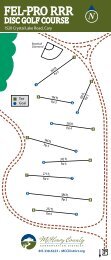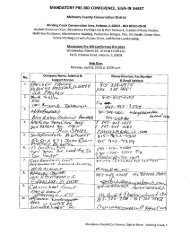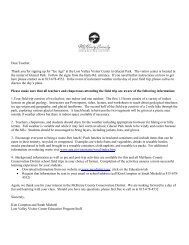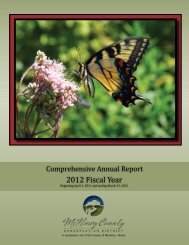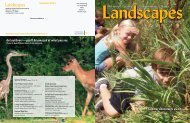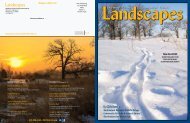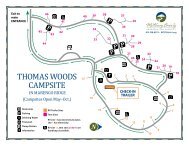General EAB Brochure - Illinois Department of Agriculture
General EAB Brochure - Illinois Department of Agriculture
General EAB Brochure - Illinois Department of Agriculture
Create successful ePaper yourself
Turn your PDF publications into a flip-book with our unique Google optimized e-Paper software.
Emerald Ash BorerThe emerald ash borer, (Agrilus planipennisfairmaire) is a small (1/2 inch long, 1/8 inch wide)metallic green beetle native to Asia. While it wasfirst found in Michigan in 2002, it is likely that thebeetle population had been established quite a fewyears before discovery. Discovered in Kane County<strong>Illinois</strong> in 2006, the beetles’ presence has sincebeen found in Bureau, Cook DeKalb, DuPage,Kendall, Lake, LaSalle, McHenry, McLean and Willcounties. <strong>EAB</strong>’s natural spread is moderate, but itsartificial spread can be rapid by people unwittinglytransporting this pest through infested firewood andlandscape waste. Artificial movement <strong>of</strong> infestedtrees has exacerbated the <strong>EAB</strong> problem in <strong>Illinois</strong>and North America. To protect our ash trees, it isour responsibility to minimize the spread <strong>of</strong> <strong>EAB</strong>by not transporting firewood outside <strong>of</strong> its localarea. Fireplace owners should buy firewood from aknown local source and burn all <strong>of</strong> it before May 1.Campers should buy firewood at your destinationand/or burn all wood before leaving the campsite.Ash TreesAsh trees are very common in landscapes and mostspecies, mainly white ash (Fraxinus Americana) andgreen ash (F. pennsylvanica) are native to <strong>Illinois</strong>forests. It is estimated that as much as 20 percent<strong>of</strong> street trees in the greater Chicagoland area areash.Ash leaves & twigDiebackSuckers on trunkor base <strong>of</strong> treeSigns andSymptomsThe most visible sign <strong>of</strong>infestation is crown dieback.Branches at the top <strong>of</strong> thecrown will die and morebranches will die in subsequentyears. As the tree declines,‘suckers’, or new youngbranches, will sprout from thebase <strong>of</strong> the tree and on thetrunk. The bark may also splitvertically and woodpeckers mayfeed on the beetle leavingvisible damage on the bark.Successful treatments withinsecticides are limited butcontinue to be studied. All ashtrees near any new infestationwill most likely become infestedand die.Life CycleThe adult emerald ash boreremerges May - July and thefemale lays numerous eggs inbark crevices and betweenlayers <strong>of</strong> bark.The eggs hatch in 7-10 days intolarvae which bore into the treewhere they chew the innerbark and phloem creatingwinding galleries as they feed.This cuts <strong>of</strong>f the flow <strong>of</strong> waterand nutrients in the tree,thereby causingdieback and death.Actual sizeLarvaS-shapedgalleriesCharacteristics<strong>of</strong> ash:Seeds- Compound leaves made up <strong>of</strong> sevensmall, glossy green leaflets (5-9 leaflets).- Leaves, twigs and branches growsymetrically in opposite pairs.- Bark <strong>of</strong> mature trees is gray andfurrowed, <strong>of</strong>ten appearing in a diamondpattern.- Some ash trees will produce smallcanoe paddle-shaped seeds.- Seedless ash trees are common.- Some ash produce conspicuous hard,brown “flower galls” on their twigs.Bark slitsEmergence holeShown actual size <strong>of</strong>1/8” and D-shapedAdult beetles emerging fromtrees will leave a unique “D”shaped exit hole. This is asmall 1/8 inch diameter distinctly“D” shaped hole that mayappear anywhere on the trunkor upper branches.Other Stressors:Ash trees may suffer froma number <strong>of</strong> insect diseaseor other problems that cancause similar symptoms.Native borers also attackash trees and leave differentexit holes. The round or ovalholes <strong>of</strong> native insect borersare not “D” shaped and areusually smaller or largerthan those <strong>of</strong> the <strong>EAB</strong>.
You Can Help...•••DO NOTMOVEFIREWOODEmerald Ash Borer can easily be transported inash logs.Purchase firewood locally (within county) from aknown source.Be sure to use all the firewood in the cold monthsso that no hidden <strong>EAB</strong> larvae or adults can surviveon logs left through the spring.• There are both state and federal quarantines inplace that restrict themovement <strong>of</strong> ash logs,branches or othermaterial in certainareas. The entire state<strong>of</strong> <strong>Illinois</strong> is undera federal quarantine,which restricts themovement <strong>of</strong> regulatedarticles across the stateline. Additionally, aninternal state quarantineis in effect for all or parts<strong>of</strong> 25 counties in northeastern<strong>Illinois</strong>. If you giveor sell any ash stock or other hardwood originatingfrom within the internal state quarantinedarea, inform the person receiving the wood <strong>of</strong>that fact and the restrictions on wood movement.• Check www.<strong>Illinois</strong><strong>EAB</strong>.com for more detailedinformation.•Monitor the health <strong>of</strong> ash trees. Look for deadand dying branches at the top <strong>of</strong> the tree’scrown and other <strong>EAB</strong> signs and symptoms.If You Think You HaveEmerald Ash Borer:If you suspect your tree has <strong>EAB</strong>, please takesome digital photos <strong>of</strong> the tree and close-ups <strong>of</strong>the symptoms it is expressing and email thosewith contact info to: agr.eab@illinois.gov.For assistance in identifying suspectinsects and symptoms:o Contact your city or village forester,arborist or public works <strong>of</strong>ficial for assistanceo In the City <strong>of</strong> Chicago, contact312-74BEETL (312-742-3385)o Contact the <strong>Illinois</strong> <strong>Department</strong><strong>of</strong> <strong>Agriculture</strong> at 800/641-3934 orvisit www.<strong>Illinois</strong><strong>EAB</strong>.como Contact your local University <strong>of</strong> <strong>Illinois</strong>Extension <strong>of</strong>fice by visitinghttp://web.extension.uiuc.edu/state/index.htmlor by calling 217-333-5900o Visit www.emeraldashborer.info orhttp://na.fs.fed.us/fhp/eab/o Contact The Morton Arboretum PlantClinic at 630-719-2424 orwww.mortonarb.org/o Contact a certified arborist. To findone in your area, visithttp://www.illinoisarborist.orgo Call the national <strong>EAB</strong> hotlineat 866-<strong>EAB</strong>-4512.Printed by the authority <strong>of</strong> the State <strong>of</strong><strong>Illinois</strong> (PA#69-12/11)Emerald Ash Borerwww.<strong>Illinois</strong><strong>EAB</strong>.comDivision <strong>of</strong> Natural ResourcesBureau <strong>of</strong> Environmental ProgramsPO Box 19281 ~ Spfld., IL 62794-9281217/785-2427 voice/TDD




